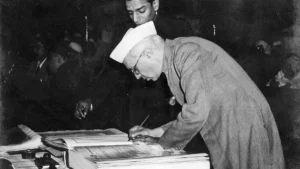The Constitution of India was influenced by various sources and events in the history of India. The pre-independence era under British colonial rule set the stage for constitutional reforms in India.
The British came to India as traders but gradually became rulers. They imposed their laws and policies on India, which often exploited and discriminated against the Indians. They also divided India into different regions and states, some under their direct control and some under the control of local rulers or princes. The Indians resisted the British rule in various ways, such as revolts, rebellions, movements, and campaigns. They also demanded more rights and representation in the governance of India. Some of the leaders who inspired the Indians were Raja Ram Mohan Roy, Bal Gangadhar Tilak, Mahatma Gandhi, Jawaharlal Nehru, Sarojini Naidu, Subhash Chandra Bose, Bhagat Singh, B.R. Ambedkar and many others.
The British responded to the Indian demands by introducing some reforms and acts, which gave some concessions to the Indians, but also maintained their own supremacy and control. Some of these acts were the Regulating Act of 1773, the Government of India Act of 1858, the Indian Councils Act of 1861, the Indian Councils Act of 1909, and the Government of India Act of 1919.

Jawaharlal Nehru signed the Constitution at the final session of the Constituent Assembly on January 24, 1950. | Photo Credit: The Hindu Archives
Indian Councils Act of 1861
The Indian Councils Act 1861 was a major piece of legislation that introduced a system of indirect elections and representation to the British Indian government. It was the first time that Indians were given a say in the governance of their country.
The Act was introduced by the British government in response to the growing demands for reform from the Indian people. The Indian Rebellion of 1857 had shown the British that they needed to give Indians more of a voice in the government if they wanted to maintain their control over the country.
The Act created Legislative Councils in each province of British India. The councils were composed of both appointed and elected members. The appointed members were typically British officials, while the elected members were chosen by a small group of wealthy Indians.
The Legislative Councils had very limited powers. They could only advise the governor on matters of legislation and administration. However, the establishment of the councils was an important step forward in the development of Indian self-government.
The Indian Councils Act 1861 was amended in 1892 and 1909 to expand the powers of the legislative councils and to increase the number of elected members. However, the reforms did not go far enough to satisfy Indian nationalists, who continued to demand full self-government.
Indian Councils Act of 1909
The Indian Councils Act of 1909, also known as the Morley-Minto Reforms, introduced a number of important changes to the system of government in British India. The Act was named after John Morley, the Secretary of State for India, and Lord Minto, the Viceroy of India.
The most important change introduced by the Act was the expansion of the legislative councils at both the central and provincial levels. The councils were now composed of a mix of elected and appointed members, but the proportion of elected members was increased from 37% to 50%. The Act also introduced a system of separate electorates for Muslims, giving them a guaranteed number of seats in the legislative councils.
The Act was eventually replaced by the Government of India Act of 1919, which introduced a more comprehensive system of representative government in British India.
Indian Councils Act of 1919
The Indian Councils Act of 1919, also known as the Montagu-Chelmsford Reforms, was named after Edwin Montagu, the Secretary of State for India, and Lord Chelmsford, the Viceroy of India.
The most important change introduced by the Act was the introduction of a system of dyarchy in the provinces. This system divided the subjects of government into two lists: the reserved list and the transferred list. The reserved subjects, such as law and order, remained under the control of the British government. The transferred subjects, such as education and healthcare, were transferred to the control of Indian ministers.
The Act also expanded the powers of the provincial legislative councils and gave them the power to vote on the provincial budget. The councils were now composed of a majority of elected members, and the number of Muslim seats was further increased.
The Act also introduced the creation of a bicameral legislature at the central level, the Council of State (upper house) and the Legislative Assembly (lower house), and a system of direct elections for the Legislative Assembly.
The Indian Councils Act of 1919 was an important step forward in the development of Indian self-government. It was the first time that Indians were given a significant degree of control over their own governance. However, the Act also came under criticism from some Indian nationalists, who argued that it did not go far enough in granting Indians a say in their own governance.
The Act was eventually replaced by the Government of India Act of 1935, which introduced a more comprehensive system of representative government in British India.
The Nehru Report of 1928
In 1928, the Indian National Congress appointed a committee to draft a constitution for India. The committee was headed by Motilal Nehru and it included other prominent leaders such as Jawaharlal Nehru, Subhas Chandra Bose, and B.R. Ambedkar. The committee’s report, which was known as the Nehru Report, was the first attempt to draft a constitution for India.
The Nehru Report was rejected by the British government, but it provided a foundation for the future Constitution of India. The report called for a federal system of government with a strong central government. It also called for fundamental rights for all citizens.
Continue to the next section: Historical background of the Constitution (Part 2)
